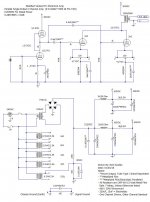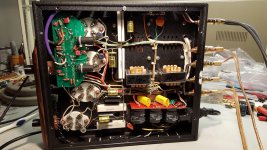I start by introducing myself. My name is Giuseppe, I am 58 years old and I love to listen mainly to classical music.
First of all, I beg you not to laugh at my ignorance when I have explained the "question" to you ... but I am an expert in music but not in technology.
I am happy owner of a Yarland FV35-a integrated amplifier, whose final stage consists of a parallel single ended of 2 triodes 2a3 per channel. I tried to remove alternately the central and side valves and was surprised to see that the amplifier continues to work if the central valves remain mounted, while it remains silent if I remove the central valves to leave the lateral ones in place. What does this means? It means that two valves performs the function of "primary" (I am using a non-technical language)? The word "parallel" would suggest that the two triodes of the final stage should act "in parallel" and therefore there should not be a "primary" and a "secondary" valve. Or is not it?
I also noticed that listening only with a valve by channel, beyond the obvious half of the power (which in my room of 16 square meters with 94db speakers is not perceptible) the sound is more "smooth" and natural. But I ask you: doing so risk of ruining the amplifier?
I apologize for my lack of technical competence and I thank everyone for the answers you want to give me.
First of all, I beg you not to laugh at my ignorance when I have explained the "question" to you ... but I am an expert in music but not in technology.
I am happy owner of a Yarland FV35-a integrated amplifier, whose final stage consists of a parallel single ended of 2 triodes 2a3 per channel. I tried to remove alternately the central and side valves and was surprised to see that the amplifier continues to work if the central valves remain mounted, while it remains silent if I remove the central valves to leave the lateral ones in place. What does this means? It means that two valves performs the function of "primary" (I am using a non-technical language)? The word "parallel" would suggest that the two triodes of the final stage should act "in parallel" and therefore there should not be a "primary" and a "secondary" valve. Or is not it?
I also noticed that listening only with a valve by channel, beyond the obvious half of the power (which in my room of 16 square meters with 94db speakers is not perceptible) the sound is more "smooth" and natural. But I ask you: doing so risk of ruining the amplifier?
I apologize for my lack of technical competence and I thank everyone for the answers you want to give me.
It's not a good idea to change anything in any device without proper knowledge. :-(
Are you make out parts from your car's engine?
Recensie van de Chinese Yarland FV35A 2A3 PSE buizenversterker.
As you can see in schematic two 2A3 output tube paralleled per side (left, right channel).
ALL four tubes current impact to power supply's voltages (300V, 294V).
If you remove any of output tubes, the voltage start growing, the tubes operating point changing. If the 2A3 operating point is near to the dissipation limit, over dissipation can damage your tubes.
If the growing high voltage enough high -and reservoir capacitor's voltage limit not oversized- you can ruin out the power supply capacitors.
Are you make out parts from your car's engine?
Recensie van de Chinese Yarland FV35A 2A3 PSE buizenversterker.
As you can see in schematic two 2A3 output tube paralleled per side (left, right channel).
ALL four tubes current impact to power supply's voltages (300V, 294V).
If you remove any of output tubes, the voltage start growing, the tubes operating point changing. If the 2A3 operating point is near to the dissipation limit, over dissipation can damage your tubes.
If the growing high voltage enough high -and reservoir capacitor's voltage limit not oversized- you can ruin out the power supply capacitors.
Needs very tightly matched pairs.It needs a matched quartet of tubes
Individual cathode R//C (R8//C4, R13//C4) helps a little, but no possibility changing R8 or R13.
Interesting. If the schematic is correct, removing either tube (center or side) should make sound still. Unless one side of the paralleled output circuit is dead, it should make sound.
Note: removing one side can cause stress to the remain side. This is from elevated B+ (from 1/2 the tube current draw) and excessive output loading. ie. Like hooking up an 4 ohms speaker on a 16 ohms terminal. I would only do this with a lower than normal AC power line voltage)
Note: removing one side can cause stress to the remain side. This is from elevated B+ (from 1/2 the tube current draw) and excessive output loading. ie. Like hooking up an 4 ohms speaker on a 16 ohms terminal. I would only do this with a lower than normal AC power line voltage)
If the growing high voltage enough high -and reservoir capacitor's voltage limit not oversized- you can ruin out the power supply capacitors.
Agree with your points. However, a properly designed amp should take into account the potential failure of any tube, or an open connection. The power supply caps should be rated to tolerate an unloaded supply.
Sheldon
There are at least two different versions of this amp. Unless you remove the bottom cover and verify the circuit, I would be suspect of ANY schematic of a Chinese amp. I know this from experience.
As long as the power supply voltage does not rise too high, operating the amp with a tube removed from each channel should be OK. I'll have to measure it on mine and report back.
Think of the two parallel output tubes in the same manner as those trucks you see with double tires (parallel) on the rear. If one tire blows out, then the other tire continues to operate, but with an increased load.
Mine came as an SRPP version. It looks like they may have changed this to a different circuit as production went on.
As long as the power supply voltage does not rise too high, operating the amp with a tube removed from each channel should be OK. I'll have to measure it on mine and report back.
Think of the two parallel output tubes in the same manner as those trucks you see with double tires (parallel) on the rear. If one tire blows out, then the other tire continues to operate, but with an increased load.
Mine came as an SRPP version. It looks like they may have changed this to a different circuit as production went on.
Attachments
Last edited:
By "center tube" do you mean the small one? If so, that's a driver tube, so the output would fall away. It will still work with one power tube, but you are taking a chance of damaging the amp. because you have changed the effective primary impedance. Don't run the amp, this way.
Removing one of the output tubes you will not damage this particular amp design. The transformer impedance is "double" what it is supposed to be for maximum power.
By removing one tube (per channel) the effective transformer impedance will be 2500 Ohms with a 4 Ohm load.
By removing one tube (per channel) the effective transformer impedance will be 2500 Ohms with a 4 Ohm load.
- Status
- Not open for further replies.
- Home
- Amplifiers
- Tubes / Valves
- Single ended parallel (questions from an ignorant)

